PLUM SAWFLY
The picture above shows the damage done to plums by the plum sawfly (Hoplocampa flava). From the outside the plum looks OK, may be a small brown mark on the skin but nothing more. But inside, the plum is completely inedible. You may also notice one or two small hardened drops of resin on the fruit which are the tree’s response to being attacked.
In spring the sawfly emerges from the soil and lays eggs on the blossom of plum trees. When the plums develop the little caterpillars eat their way into the centre of the plum and feed off it as the plum develops.
Plum Sawfly is difficult to control using organic methods, the only one being available is a pheromone trap which goes some way to controlling the disease.
Look for the giveaway brown mark on fruits and when they are forming pick the fruit off and burn them, this will help in controlling the disease next year. Burn any fallen fruit which is unusable.
The chemical deltamethrin sprayed when the blossom is falling off will definitely help control plum sawfly.
Another effective method to control this pest is to break up and turn over the top 8cm / 3in of soil with a trowel around the tree in February to March. This will bring the bugs to the surface and birds will eat them.
PLUM TREE LEAF CURL
This is often referred to as Plum Leaf Curl Virus or Plum Leaf Curl Disease, both are misleading. There is no such virus or disease, the curling of leaves is caused by some other factor. In the vast majority of cases it is aphids which cause the leaves to curl. Often these aphids are called leaf curl aphids.
To check for aphids, uncurl the leaves and look for signs of aphids. If you can’t see any, look through a magnifying glass or take a close up picture and expand it. Often, aphids are not visible to the naked eye.
It’s important to diagnose aphids correctly because if you assume it’s a virus, disease or a fungus then you will may well end up spraying with a fungicide or other spray which will not kill the aphids.
APHIDS
Plum trees are often attacked by aphids and the first signs are young leaves curling up, this is often referred to as Plum Leaf Curl. They are not normally discoloured just curled. If you uncurl the leaf the aphids will be seen inside – small green, white or light brown insects. By themselves they probably won’t cause too much damage but often they secrete a sticky juice which attracts unwanted diseases.
We have written a whole page on identifying and treating aphids and it can be found here. Follow that advice and almost certainly your plum tree will live through the attack with no bad side-effects. Two specific types of aphids attack plum tree, the Plum Leaf-Curling Aphid and the Mealy Plum Aphid. Both are treated exactly the same as other aphids. The Plum Leaf Curl tend to attack from April to June whereas the Mealy Plum Aphid attacks in July to early September.
PINK MAGGOTS INSIDE PLUMS
This is caused by the caterpillar of the plum moth (Grapholita funebrana) and makes the fruit totally inedible. It’s a particularly difficult pest to identify unless you cut a plum open, or worse still bite into an affected plum. You will see a pinkish small caterpillar / maggot inside with brown stuff in the hole it has made inside the plum – that’s its excrement! Other signs are dried drops of gum which form near the entry hole, premature fruit drop and discolouration of the plums.
There are chemical sprays which may help (one of the most common is Resolva Bug Killer) but there is nothing that could convince me to spray chemicals over plums and then eat them. The other problem with chemical sprays like Resolva is that they kill pollinating insects. The alternative is the plum moth pheromone trap which attracts the male moths. The moths then stick onto the trap thus reducing the population of male moths. If you try this method follow the instructions exactly for the best effect.
Both Czar and Victoria plum trees seem to be particularly vulnerable to plum moth attack, other varieties less so. The lifecycle of this pest starts in May when the female moths lay eggs on the underside of growing plums. The eggs hatch and then dig into the plum and feed on it. When fully developed the caterpillar comes out from the plum and builds itself a small cocoon where it pupates (changes) into a fully grown moth. Favourite places for doing this are under cracks in the bark or on the soil below the tree.
PIGEONS
Pigeons can be a real problem with plum trees (and cherry trees as well), they first go for the leaves and rip them apart. They then start to damage the new twig like branches, possibly simply because of the weight of the birds perching on them although some believe the pigeons peck at them. Either way the result is the same, leaves that are effectively destroyed and major damage to newly growing stems.
The damage occurs typically in April to June time and the trees will fail to develop fruit in that year. There is no agreement as to exactly why pigeons do this. Preventing the damage depends to some extent on how big your plum tree is. Smaller plum trees can be protected with netting which is simply draped over the tree and this works well. Fruit cages are another permanent solution which prevent 100% of the damage.
For larger fruit trees, where it is not an option to surround them with a physical barrier, the options are more limited. Methods which have worked in some cases include those listed below:
- Hang old CDs from the branches to scare the birds
- Cut the bottom out of plastic bags and tie loosely to branches – unattractive maybe but it seems to be the most successful way to scare pigeons. The bags move about in the wind
- Plastic model of birds of prey tied high up on the tree and moved occasionally. These can be bought online
One method which has been proven to be a failure is to try and attract the pigeons to other areas of the garden / allotment with bird food. What then happens is that more pigeons are attracted, they eat the bird food and then turn their attentions to the tree.
BROWN ROT OF PLUM TREES
The symptoms of brown rot in plums are unlikely to be mistaken for any other disease. The skin of the affected plums will have grey, small raised bumps on it and if you cut into the plum the flesh will be discoloured and rotting where the bumps are most numerous. If left, the plum will shrivel completely. The picture below shows a plum affected by brown rot at a relatively early stage.
Insects, birds and fruit splitting because of lots of rain, all damage the fruits allowing this fungus to gain entry. Once a plum is infected it can infect other nearby fruit as well and very quickly the whole tree can become infected. Most at risk are plum trees that bear fruit very closely together (Victoria plum trees are particularly prone to Brown Rot) There are no chemical sprays available to the amateur gardener but if you follow the action plan below this disease can be eradicated:
- As soon as you notice affected plums remove and destroy them.
- Remove and use any fallen plums, do not let them remain on the ground.
- Pick fruit as soon as it is ripe, do not let them over-ripen on the tree.
- If your plum tree is very tall with fruit high up that you cannot reach then you have a problem. With trees of this size the plum fruit higher up cannot be harvested and is a prime target for Brown Rot. Invest in a pair of long-handled loppers and cut the highest fruit bearing branches off. Late spring / early summer is the ideal time to do this.
- Thin the fruit on plum trees as recommended on this page. Too much fruit causes them to rub together allowing fungi such as Brown Rot to enter, it also prevents good air circulation.
See also the question near the end of this page about the effect of untreated Brown Rot in later years.
WINTER MOTH
The signs to look for are small green caterpillars on the leaves, buds which fail to develop and leaves with holes in them. This pest is the Winter Moth and will normally become apparent in late March to May. The first indication will be tiny caterpillars on and around fruit and leaf buds. They may spin silken threads and hang from the tree twigs. They then grow into larger caterpillars and will eat leaves, buds and almost all parts of the foliage.
Read our Winter Moth page for more details.
SCALE INSECTS
There are many forms of scale insects which attack a variety of plants but one in particular can be a problem with plum trees, it is named the Lecanium Scale. The picture below shows just how scary looking this pest is but, although serious if left to its own devices, it is not impossible to control. At maturity they look like pea-sized growths which are purple brown on stems and young branches.
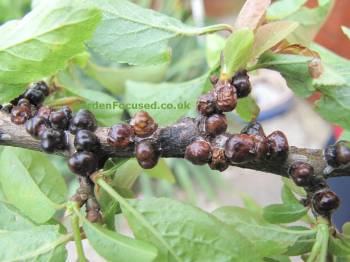
Picture of Lecanium Scales on a plum tree
(click to enlarge picture)
First, exactly what is it? What you see in the picture above is a scale insect which feeds on the sap of a twig, branch or leaf. Their life cycle begins when the scales overwinter and then lay eggs around May time – 200 or so eggs which are beneath the parents body. In May to mid July the eggs hatch and crawl away to new parts of the tree. This is the stage at which pesticides can be effective, when the insects are moving about. When the insects find a suitable position they clamp their jaws onto the bark of tree and begin to feed on the sap of the tree without moving again.
If you can identify the period in May /June when the young scale insects are on the move spraying with an insecticide will kill them. Ask at your garden centre for an appropriate spray. In general though, sprays suitable for killing aphids will also kill moving scale insects.
If you miss this stage of their lifecycle then a plant oil winter wash treatment (again ask at your local garden centre) in December to January will effectively suffocate many of the overwintering bugs.
The easiest method, if your tree is a manageable size, is to manually remove the scale insects around May when they are clearly visible but have not yet hatched their eggs. If you are squeamish about removing them with your fingers use a toothbrush and some diluted washing up liquid to brush them off. A gentle spray after with a hose should then remove all traces of them.
PLUM POCKET
Relatively unknown in garden cultivated plum trees in the UK, Plum Pocket is becoming increasingly common. The symptoms are quite unusual and hard to mistake for any other pest or disease. Young fruit begin to to appear longer than normal and slightly larger, this normally becomes visible around mid June time. The next symptoms are white marks on the skin of affected plums, this is a fungus forming. Soon after the plums will begin to wither and die. Normally only around 50% of the plums are affected.
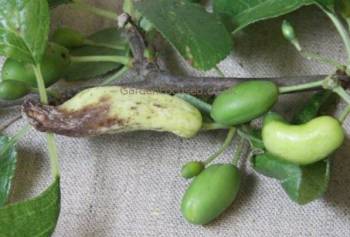
Plum fruit affected by Plum Pocket
Both the picture above and below are courtesy of GardenFocused reader Walter A who is quite clearly a better photographer than I am! The above picture show young fruit on the right developing in the typical elongated fashion. The left hand plum is more developed and is clearly suffering from Plum Pocket.
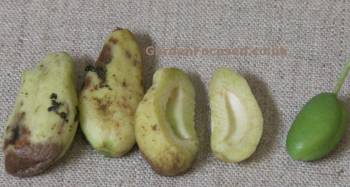
Plum Pocket – no fruit stone has formed
If the fruits are cut open at any stage no stone will be found, just an empty “pocket” of white flesh as can clearly be seen from the picture above. As the plums wither they turn brown and fall off. The disease is caused by the fungus Taphrina pruni and affects plum and damson trees.
LIFE CYCLE OF PLUM POCKET
The spores of the fungi are spread through air and water from nearby affected trees. It is more commonly found on wild plum and damson trees so if you have any nearby take a careful look at them for signs of infection. The spores become airborne in early spring, land on your tree and lodge in the bark and newly forming branch buds. There they stay, causing no damage, until the next spring. They then multiply and begin to attack fruit buds and young fruit and cause the damage mentioned above.
TREATING PLUM POCKET
The spores of the fungi are spread through air and water from nearby infected trees and also from the affected tree itself. Once the fruit are initially affected there is no way to save them that year. Treatment is aimed at limiting the spread of the spores and at the same time spraying the tree before fruit buds form in early spring.
The first course of action is to remove and burn all affected fruit including those which have fallen to the ground. Take a close look at the tree and if you notice any unusually thick clusters of twigs growing from branches, prune them off because in all likelihood they are infected. As part of the normal pruning process remove any twigs and branches which look unhealthy.
A fungicide sprayed onto the tree will also limit damage very considerably. The best one we know of for Plum Pocket is Westland Plant Rescue Fungus Concentrate, the active ingredient is Difenoconazole. Spray the tree once in November and then again in March.
The copper fungicide Bordeaux Mixture has previously been recommended as a spray to prevent Plum Pocket. However it has now (or soon will be) withdrawn from sale in the UK. Currently there are no alternatives which have been scientifically proven to be anywhere near as effective as Bordeaux Mixture
Various alternatives are suggested, for example aspirin solution or milk, but none have been proven to have any effect.
WHITE POWDER ON PLUM TREE LEAVES
Plum trees often suffer from POWDERY MILDEW which is a fungal disease. The powder you see on the leaves are the spores of the fungus. We have a page dedicated especially to identifying and treating powdery mildew which can be found here. As far as plum trees are concerned the problem is most frequently caused by bad air circulation especially in the centre of the tree. Although plum trees withstand infrequent pruning better than most other fruit trees, this fungus often occurs where the foliage and branches are crowded.
Where the disease is left to progress secondary infections and pests may well attack the weakened tree. Aphids in particular (please use a magnifying glass to examine the leaves) are attracted to weakened trees and they may cause the mildew to turn sticky in places.
SILVER LEAF DISEASE
Most commonly found in plum tree it can also affect other trees. There are two symptoms which are commonly noticed. The first is silver sheen to some, though not all, of the leaves. The second symptom you may notice is visible only if you prune branches 3cm / 1in or more wide. There may well be a brown stain in the wood.
Read our detailed article to positively identify Silver Leaf disease, the causes and how to treat it.
LEAVES HAVE LOTS OF LITTLE HOLES
The most likely cause of this problem is Shot hole (also known as Coryneum Blight) and this section covers that disease. Similar holes can also be caused by Canker (damage to the bark will also be clearly present) and the Shot hole Borer (stems and trunk have holes in them but not the leaves).
The most obvious symptom is the appearance of lots of holes in the leaves. Initially they are brown circles of dying or dead tissue, as the leaf grows the brown circles fail to grow and eventually they fall off leaving the trademark round holes. These can join up over time leaving bigger holes in the leaves. Less obvious signs are brown marks around developing buds and / or grey spots on the fruit which may also include a resinous gum.
The disease is a fungal infection which thrives in damp and crowded conditions. It does respond to chemical treatment both in spring and autumn. In spring spray with an anti fungal mix such as Westland Plant Rescue Fungus Concentrate.
The copper fungicide Bordeaux Mixture has previously been recommended as a spray to prevent fungal diseases in fruit trees. However it has now (or soon will be) withdrawn from sale in the UK. Currently there are no alternatives which have been scientifically proven to be anywhere near as effective as Bordeaux Mixture
Various alternatives are suggested, for example aspirin solution or milk, but none have been proven to have any effect.
The fungus can also be controlled simply by reducing the number of affected leaves, buds and correct pruning especially of the lower parts of the centre of the tree. Firstly, remove all fallen leaves and twigs from around the base of the tree. If the area is water logged, try to provide good drainage to reduce humidity. Prune off all affected twigs which have infected buds.
Plum trees such as Victoria are more likely to be affected by Shot hole because they tend to grow branches and foliage close together – perfect conditions for this fungus.
STEMS AND BRANCHES HAVE ROUND HOLES
The picture below describes the symptoms very well. Round holes in the bark of the tree are visible, most frequently in the main stem. Repeated attacks result not only in holes in the bark but the bark begins to lift off the surface of the inner wood. The Shot hole Borer is most common on plum, apple, pear and cherry trees.
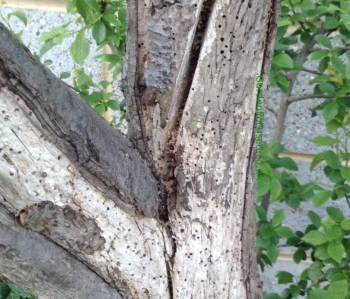
Shot hole Borer damage in a Plum Tree
The holes are caused by the Shot hole Borer beetle and the life cycle is as follows:
- The adult beetles (black / dark brown) bore small holes into the wood in May / June time where they lay about 50 eggs.
- The eggs pupate into larvae which feed on the wood.
- About two months later the larvae have turned into adult beetles and they bore their way out of the wood leaving the characteristic small round holes.
- In August / September the adults then bore their way back into the bark where they lay eggs.
- The eggs overwinter and appear as adults in May / June time starting the lifecycle again.
In most cases plum trees which are affected are already weak and the shot hole borers cause even more damage. In the UK there are no insecticide / pesticide sprays to prevent or cure shot hole borers. Your only option (with only a very slim chance of success) is to improve the general health of the tree. In reality, it is probably best to dig up the tree, burn it and start again. Do not plant new fruit trees in the same position.
UNDERSIDES OF LEAVES BROWN – PLUM RUST
Rust affecting plum trees is caused by the fungus Tranzschelia pruni-spinosae. It’s normally first noticed in August time with the underside of the leaves having a rusty-brown coating to them. The top sides of the leaves may also have small, irregular black marks on them, see the pictures below. Some varieties of plum tree, Victoria especially, are more prone to rust compared to others.
It does not affect the fruit, if the fruit are showing signs of disease you have another problem as well as rust. There are currently a few sprays that are available to the amateur gardener to control rust but none are designed to be sprayed on plum trees (or other edible crops). You will see this specifically mentioned on the labels of the products.
Whilst rust can be a very serious problem for some plants (e.g. some pine trees) it is not a serious problem in plum trees because it occurs late in the year. Rust is spread on the wind and it overwinters on / just below the ground on plant matter, leaves especially. It also overwinters to a small degree in crevices on the bark of plum trees.
In any year there will be several sources of rust and it is almost impossible to eradicate them all. The following actions however will limit the spread of the disease and in many cases all make it unnoticeable:
- Rust thrives in humid conditions and this can be minimised by ensuring there is good air circulation through the middle of the tree. If you have a problem with rust in one year pay particular attention to thinning out the centre of your plume tree when you prune it in June / July the next year.
- Plum tree rust primarily overwinters on leaves which have fallen to the ground. In the year you notice rust as being a problem thoroughly clear up all fallen leaves as often as possible. Do the same in the next year even if the rust appears to be minimal.
- Do NOT remove infected leaves from the tree, wait until they fall to the ground. Leaves infected with rust are still capable of supplying nutrients to the plum tree especially just before they fall off.
- Rust grows best on nitrogen rich foliage, do not feed your plum tree with nitrogen rich fertilisers. If you do need to feed the tree, use long-lasting fertiliser such as blood, fish and bone.
SUNKEN, MISHAPEN AREAS OF BARK, DARK GUM OOZING FROM SURFACE
These are the classic signs of Bacterial canker. The other sign is yellowing leaves with holes in them. Click here to read our detailed article about identifying and treating bacterial canker as well as the lifecycle.
CLEAR BLOBS OF HARDENED RESIN / JELLY ON PLUMS
Plum trees which suffer from environmental stress such as hot or cold weather, fluctuating levels of moisture at the roots or similar conditions often produce plums which have small blobs of clear and hardened liquid on them, the picture below shows these blobs on plums.
There can be lots of them or just a few. As well as environmental conditions this can be caused by very localised insect damage or it can be the result of some other more serious pest or disease. The blobs themselves are not a pest or a disease but they are produced as a result of some other pest, disease or condition.
Cut an affected plum in half and look for signs of a pest, if none is found then the plum is still edible. If there are other signs then diagnose what has caused them rather than worry about blobs themselves, they are just a sign of another problem.
BLOSSOM IS PRODUCED BUT NO FRUIT
There is no one answer to this problem so you need to work through the section below to work out what is happening:
- When the blossoms are forming in early spring, through to the time when they open out, a late frost can damage the blossom. In this case the blossoms will die within a day of the frost and you will end up with a browned and clearly damaged blossom. This will not be pollinated and therefore will not set fruit. Occasionally this happens in cold years and there is nothing to be done except to put up with it and hope for fruit next year. It could also be that the tree is in a position where it will very frequently suffer from late frosts either because the area you live in is always cool or the tree could be in a frost pocket. If either of these are the case then you have two options.
- If the tree is young it can be moved to a better position.
- If it’s five years or more old then it’s probably best to think about a new, more frost resistant plum tree. Czar and Victoria are two common varieties which resist cold well.
- The blossoms are not being pollinated. In this case the blossom will be produced but will simply die off before being pollinated. The likely reasons for this are:
- The tree is not self-fertile and there is no nearby suitable pollination partner. See our page on plum tree pollination for full details. To save some time for many of you reading this, I can confirm that the two most common plum trees, Victoria and Czar, are self-fertile and do not need a pollination partner to set fruit.
- Bees are unable to pollinate the blossoms. In some areas there is simply a shortage of bees. In other areas the weather may have been too cold or too windy / rainy for a prolonged period of time which will prevent bees going out and pollinating the tree.
The above picture shows two blossoms which have finished flowering. On the left the fruit has set (i.e. the blossom has been pollinated) and this can be identified because, just below the old blossom, the fruit has a slight bulge in it. On the right the fruit has not set (i.e. the blossom has not been pollinated) and this can be identified because, just below the old blossom, the “fruit” has no bulge in it.
- If none of the above applies to your plum tree then the problem is most likely due to how the plum tree is being cared for including pruning.
REDUCED AMOUNT OF BLOSSOM
Plum and greengage trees are renowned for failing to produce blossom in their first three to four years. One year they may be fine, the next there may be very little or no blossom. They are especially liable to fail to produce blossom when a cold snap occurs at the time blossom production is just starting.
There is nothing that can be done to help other than keep them in good condition (see care instructions here) and they will most likely blossom and produce fruit the next year. With smaller trees and those in containers it is possible to net them with horticultural fleece to reduce the risk of frost damage. However, it looks unsightly and is not a practical solution with larger trees.
In some gardens, the position of the tree may prevent the shade side of the tree from producing blossom but the side facing the sun is relatively unaffected. This is caused by the shaded side suffering worst from the cold weather compared to the sunny side.
FRUIT HAVE SPLIT OPEN
The picture below says it all, the plums have large cracks in them. Typically this happens in late July to August and often just as the plums appear to be ripening.
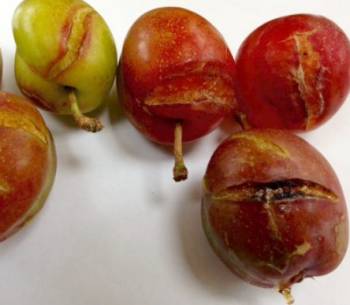
![]()
Plum fruits split open
Picture courtesy of reader Brian Kelly
Initially this is not a pest or disease it is as a result of variations in the water supply available at the roots. Typically there will be a dry period and during this time the forming plum skin will start to harden slightly as a result. Then, if there is suddenly a large amount of water available the fruits will swell but the skin can’t keep up with it and splits open.
If the plum tree is grown in a container the solution is to water more frequently but don’t water log. Try to keep the water supply constant. If the tree is in the open ground and there is a dry spell, especially if the tree is grown against a wall, water every week or so. A mulch around the tree, as far as the extent of the canopy, will also help to ensure an even supply of water.
When the fruits have split they are still perfectly edible. However they will quickly attract wasps, other pests and diseases which will spoil the fruit even more. The bottom right plum in the picture above shows a blob of semi-hard resin which is simply a side effect of the plum splitting.
PLUM TREE LEAVES HAVE WILTED
A reader of these pages sent in the picture below to illustrate the problem. The picture clearly shows wilted leaves and also yellow / brown leaves, some with small holes in them. We deal here exclusively with wilted leaves because in all probability the major problem is the cause of the wilted leaves. The brown and yellowing leaves may well be a secondary symptom.
Wilted leaves are a sign that the upper part of the tree is not receiving sufficient water but the problem may not be a lack of water. The wilting could be caused by too much water.
Unfortunately there can be several reason s why leaves wilt on a plum tree and we discuss each of them below. It is up to you to decide which is applicable in your case.
INSUFFICIENT WATER
If a tree is starved of water eventually it will suffer and wilting leaves will be one of the first indications of a problem. This situation is most common in containerised trees and young trees planted in the ground. It is rare in established trees unless something significant has occurred to the local area around the tree.
The solution is simple, water more frequently. Where the tree is in a container, temporarily moving it to a shady position as well will speed up the recovery process
TOO MUCH WATER
Too much water can have the same effect. If a plum tree is waterlogged the roots cannot absorb essential oxygen and the tree will go into a decline. This may take several weeks to damage the tree.
The soil around the tree, or in the container, will be consistently over wet (ruling out a lack of water). The solution is to cease watering the tree until the surrounding ground (or in the container) is much drier.
WATER-FLOW IS INTERRUPTED
If the main trunk of the tree is damaged or infected, water supply to the upper part of the tree may be totally or partially restricted. This can cause leaves to wilt. The most common cause of this is severe canker affecting the main trunk.
If the canker only affect specific branches, the wilting leaves will be restricted to that part of the tree. See here for our in depth article about canker and plum trees. An alternate cause can occasionally be damage caused by animals such as deer.
ROOTS ARE DAMAGED OR INFECTED
The least likely cause of wilting leaves are damaged roots but it does occasionally happen. The problem is hard to diagnose without digging the tree up and that will do it serious damage. Damage to the roots can stop the absorption of moisture and deprive the foliage of water.
The best course of action is to only dig up the tree when all hope of it recovering is lost. At that point examine the roots carefully for signs of damage and / or disease. This will allow you to take action to protect nearby trees and any new plantings.
WASPS ON PLUM TREES
Wasps can eat and disfigure plums and sometimes the damage is considerable. There have been many contraptions and devices developed over the years but, so far, the evidence is that none of them has any significant effect in reducing wasp activity.
This includes jam jars full of sugary liquid which can trap a few wasps but the numbers are so insignificant that they can be considered useless.
The latest device is a false wasp nest which is intended to scare other wasps off. We can find not a shred of evidence that this works.
If the damage caused by wasps to your plum tree is significant you can be sure that there is a wasp nest nearby. Wasps are not lazy insects but neither are they stupid, they build their nests near to a source of food and they consider plums, apples, pears etc. a very good source of food.
To make matters worse, where wasps damage the plum fruits this can often quickly attract flies who will feed on the damaged areas. They can cause further porblems and will also help transfer diseases to the plums.
The only way you can reduce damage to your fruit trees by wasps is to kill them in their nest. By all means spend time searching the internet for other solutions but there are none at the moment. Locating and killing them in their nest is the only solution.
As far as killing wasps is concerned, our advice is to leave that to expert pest companies. Only five people, on average, are killed each year from wasp and bee stings but many more suffer very bad reactions and many more acquire a lifelong fear of wasps. Leave it to the experts.
This then leaves your only contribution being to locate the wasps nest. You will need to spend a bit of time doing this. Watch the wasps when they land on fruit and then determine the direction they fly off to and follow this. With a bit of patience this will eventually lead you to their nest which is unlikely to be far away.
Apologies for not providing a quick and free solution to wasp damage on plum and other fruit trees, but the above are the facts.
WHAT IS EATING THE LEAVES OF MY PLUM TREE?
I’ll say straight away, I certainly have no solution to this problem and have never heard of one which works. If the leaves of your plum tree have significant damage to them and there is no sign of caterpillars or other bugs then the most likely cause is the wood pigeon.
They rip the ends and sides of leaves off and can do great damage to even well established trees. What causes them to do this not known because they don’t appear to eat the leaves they just rip parts of them off.
You will rarely see them doing this because they fly away at the sight of humans. There are several birds of prey plastic models which can be hung in trees that are designed to scare them off. Our advice is that they simply don’t work. Other solutions involve hanging CDs or plastic bags in the branches but these also appear to fail.
If the tree is small enough it is possible to cover with netting and this does have a good effect. Of course, with a large established plum tree this is not a sensible option.
COMMENTS / QUESTIONS LEFT BY OUR READERS
We have moved the Plum Tree comments and questions section to its own page which can be visited by clicking here. On that page you can view all the previously asked questions / answers / comments and also ask any new questions of your own.
The questions and answers page contains a large amount of additional information about plum tree problems.
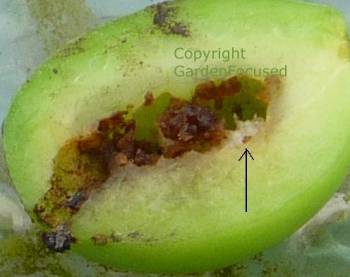
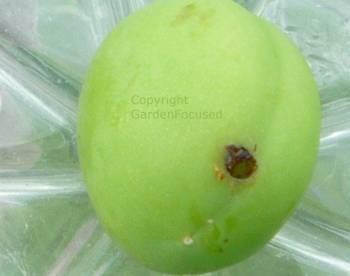
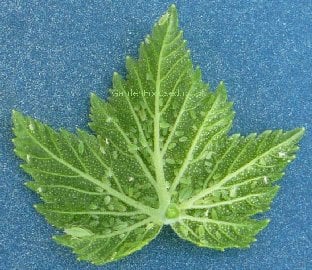
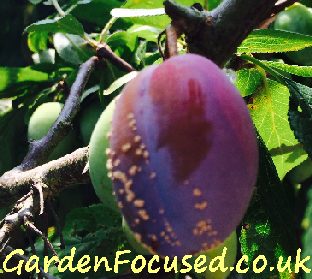
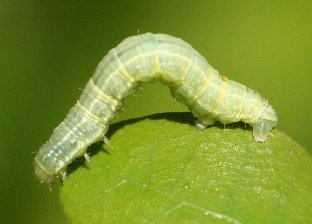
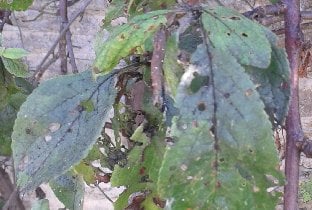



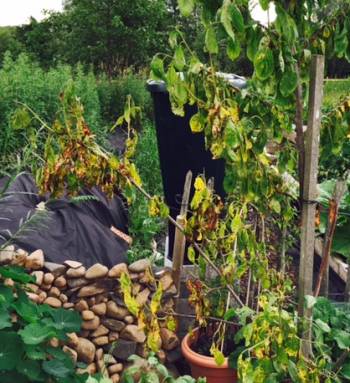
Rootstocks and Size
Pests and Disease
Guide to Planting
Pollination Groups
Care Plan and Pruning
Pruning Older Plum Trees
Top Ten Plum Tree Varieties
Plum Tree Questions and Answers
PLUM TREE PESTS AND DISEASES
By David Marks
Plum trees are one of the more resilient fruit trees and if they are given good care then they will most likely remain unaffected by pests and diseases.
Like all plants however things can go wrong and this page is designed to help you identify what the problem is and the best method of dealing with it. Each pest /disease has a clear picture showing the typical damage which can be caused.
Because plum trees can deal with a good amount of neglect, many of the problems are associated with old age. Another cause of problems with plum trees is frost. Plant them in a frost pocket and the tree will survive but fruit will suffer.